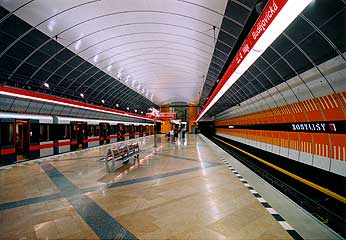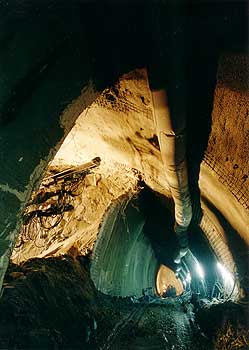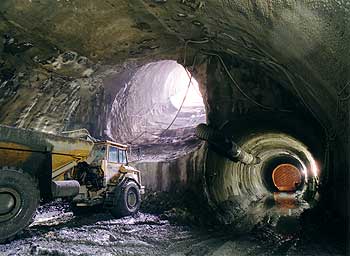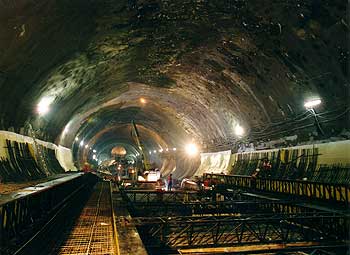Metro – line C, operational section IVC1 – single-vault station Kobylisy
 Owner:
Owner:Dopravní podnik hl. m. Prahy a. s.
Sokolovská 42
Praha 9
represented by:
Inženýring dopravních staveb a. s.
Na Moráni 3
Praha 2
Designer:
Metroprojekt a.s.
I.P.Pavlova 2/1786
Praha 2
Contractor:
Metrostav a.s.
Koželužská 5/2246
Praha 8
The first part of the fourth operational section of the Prague subway line C is 3981 m long. It leads from Holešovice station to current terminal station Ládví. The inauguration of this part took place in June 2004.
In terms of technology, the most difficult were the section passing under the Vltava River, and the single-vault station Kobylisy. Two single-track tunnel tubes placed under the Vltava River bed were built using a unique technique of dragging reinforced concrete tubes floating under the water surface to a trench pre-dredged in the riverbed. The tubes were pre-cast in a casting basin (a dry dock) on the right bank.
 Kobylisy station is the first mined single-vault station of the Prague Metro system. It was constructed using the NATM. The station tunnel is 147.9 m long, with an excavated cross-section area and a width reaching 228 m2 and 21 m respectively. Sprayed concrete SB 20 was used for the 400 mm thick primary lining.
Kobylisy station is the first mined single-vault station of the Prague Metro system. It was constructed using the NATM. The station tunnel is 147.9 m long, with an excavated cross-section area and a width reaching 228 m2 and 21 m respectively. Sprayed concrete SB 20 was used for the 400 mm thick primary lining.At both ends of the station tunnel there are mouths of two single-track running tunnels of the subway, and escalator tunnels with excavated cross section of 42 m2; an adit for a lift is found at the eastern end.
A system of partial headings was applied to the excavation, with both vertical and horizontal sequencing, for the following reasons:
- the considerable size of the excavated cross-section of the station tunnel
- underground mining activities within a densely developed area
- geotechnical conditions unfavourable for excavation
The excavation conditions were significantly affected by considerable inflows of ground water, above all in the locations where schists alternated with quartzites (inflows at the face 3 to 5 litres/second). Ground water turned the bottom to mud immediately. The average rate of pumping via the access tunnel reached 20 to 25 lt/sec.
Explosive-less methods of rock breaking prevailed (tunnel excavator Liebherr 932), with the exception of the right side of the excavated profile where blasting was used for schist disintegration.
Secondary lining contains an intermediate 3 mm thick PVC waterproofing membrane. The closed waterproofing system encases the whole tunnel circumference. The reinforced concrete liner proper (concrete grade C30) is 600 mm thick.




